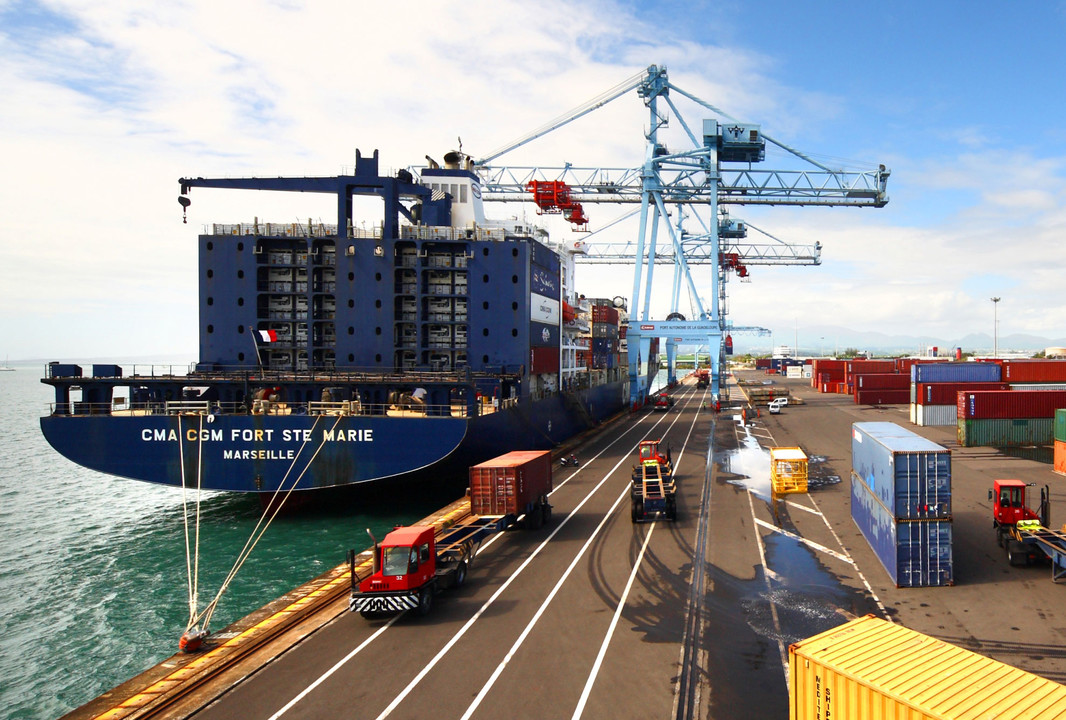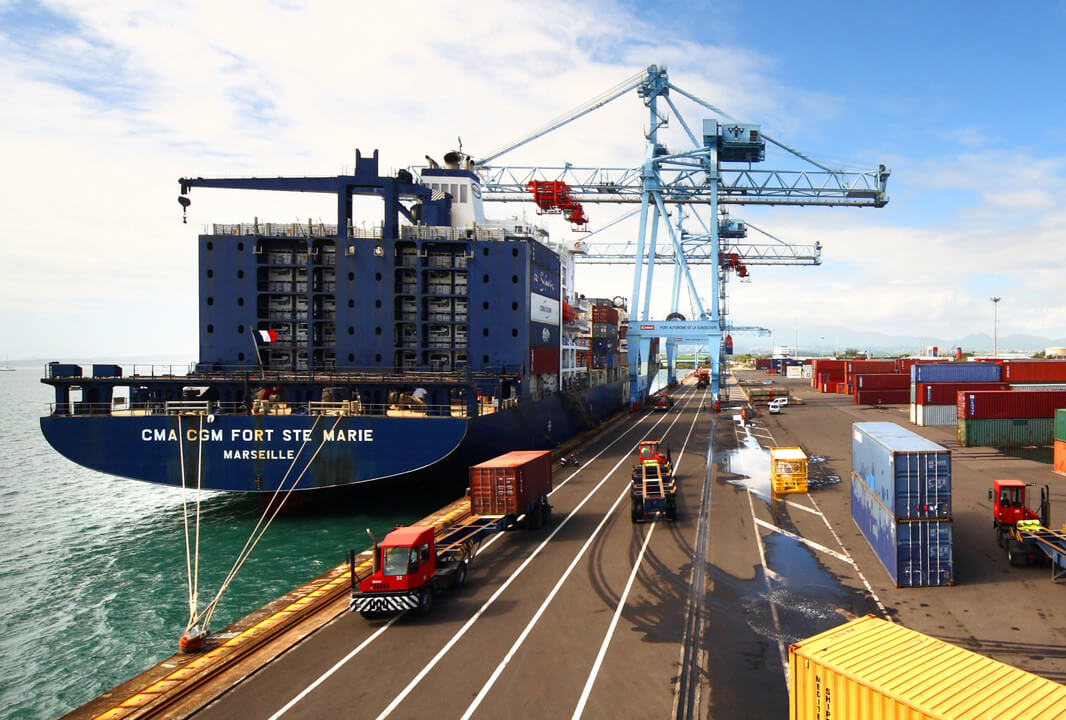A trade lane (or trade route) refers to a specific pathway along which goods are transported between two or more locations, typically across international borders. Trade lanes are established based on the flow of goods and the economic relationships between countries or regions. They encompass both maritime and air routes and play a crucial role in global supply chains by facilitating the movement of goods and fostering international trade.
Transit time refers to the duration it takes for goods or shipments to travel from their origin to their destination. It is a crucial metric in supply chain and logistics management, as it directly impacts delivery schedules, inventory levels, and customer satisfaction. Transit time encompasses the entire journey of a shipment, including transportation, handling, and processing at various checkpoints along the route.
Transloading refers to the process of transferring goods or cargo from one mode of transportation to another, typically from one type of truck or railcar to another, or from rail to truck and vice versa. This logistical practice is often employed to optimize transportation routes, reduce costs, and improve overall efficiency in supply chain operations.
A Transportation Management System (TMS) is a specialized software solution designed to streamline and optimize transportation and logistics operations within supply chains. It provides functionalities to effectively manage and control the movement of goods from origin to destination.
Transportation lead time refers to the duration it takes for goods to be transported from the point of origin to the final destination. It encompasses the time required for transportation activities, including loading, transit, and unloading, across various modes of transport such as road, rail, air, or sea.
A transshipment is the process of transferring goods from one transportation vehicle or vessel to another during their journey from origin to destination. It typically occurs at intermediary points along the supply chain route, where cargo is transferred between different modes of transportation, carriers or vessels.
Twenty-foot Equivalent Unit (TEU) is a standard unit of measurement used in the shipping industry to quantify the cargo-carrying capacity of container vessels. It represents the volume of a standard twenty-foot-long shipping container.
An Ultra Large Container Vessel (ULCV) is a massive container ship used on major trade routes, capable of carrying over 14,000 TEUs.
Vendor Managed Inventory (VMI) is a supply chain management strategy where the supplier or vendor takes responsibility for managing the inventory levels of their products at the customer's or retailer's location. In this arrangement, the vendor monitors the inventory levels based on agreed-upon criteria such as sales data or inventory levels, and initiates replenishment as needed.
Verified Gross Mass (VGM) is a term used in the shipping industry to refer to the total weight of a packed container, including its contents and packaging materials. It is a crucial requirement mandated by the International Maritime Organization (IMO) under the Safety of Life at Sea (SOLAS) convention to enhance safety in maritime transportation.
A floating structure with its own mode of propulsion designed for the transport of cargo and/or passengers. In the Industry Blueprint 1.0 "Vessel" is used synonymously with "Container vessel", hence a vessel with the primary function of transporting containers.
A vessel sharing agreement (VSA) is a cooperative arrangement between shipping companies that allows them to share space and resources on vessels for specific routes.
Vessel bunching refers to the situation where multiple vessels arrive at a port simultaneously or within a short period, leading to congestion and delays. This clustering of vessels can overwhelm port facilities, causing extended wait times for berthing, loading, and unloading operations.
A vessel call sign is a unique identifier assigned to a ship for radio communication purposes. It is used to distinguish the vessel from others in maritime communication systems, including VHF radios and satellite communications.
A vessel omission (sometimes called a port omission) occurs when a scheduled vessel does not call at a planned port during its voyage. This disruption means that the vessel skips the port entirely, which can impact the transportation and delivery schedules of goods.
In cargo shipping, vessel rotation is the planned sequence of port calls that a shipping vessel follows on its route to optimize cargo loading and unloading operations.
The timetable of departure and arrival times for each port call on the rotation of the vessel in question.
A journey by sea from one port or country to another one or, in case of a round trip, to the same port.
Warehouse utilization is a logistics metric that refers to the effective use of available warehouse space for storing goods and inventory.
Order for specific transportation work carried out by a third party provider on behalf of the issuing party.
Logistics yard management refers to the process of overseeing and controlling the movement of trucks, trailers, containers, and other vehicles within a yard or distribution center. This includes tasks such as scheduling, tracking, and coordinating the arrival, departure, and storage of these vehicles.

Global Port Performance: October
The African port performance gap: what it means for supply chains across the continent
Sub-Saharan Africa's gateway challenges persist through 2025 as Djibouti, Lomé, and Durban see anchor times worsen in the second half of the year. Here's how pxerformance has shifted across the continent's key ports from January through October.
Two halves of a year
African port performance in 2025 tells a story of hope followed by setback.
January-March: The recovery period
The year started poorly. Mombasa faced 3.6 days of average anchor time in January, among the worst globally. Djibouti logged 2.3 days. Tema struggled with 1.7 days. By February, Mombasa peaked at 3.6 days, Tema at 1.9 days.
Then came a sharp turnaround. By March, Mombasa had dropped to 1.2 days (a 66% improvement from peak), Djibouti fell to near zero, Tema reached 0.67 days. The continental average anchor time dropped from 1.77 days in January to 0.61 days in March (a 65% improvement).
April-June: Sustained efficiency
Through mid-year, many African ports maintained their gains. By June, only six ports exceeded 0.5 days average anchor time. Mombasa had stabilized at 0.66 days. Tema held at 0.54 days.
September-October: The reversal
Then came autumn, and three major patterns emerged.
Djibouti's deterioration accelerated from near zero days in March to 3.56 days by October, the highest globally and worse than its January starting point.
Southern and West Africa worsened sharply. Durban jumped from 0.54 days in August to 1.17 days by October (a 117% increase in two months). Lomé nearly doubled from 0.81 days in January to 1.64 days, with most deterioration coming after August.
East African gains partially held. Mombasa finished October at 1.45 days (down from 3.6 days peak but up from 0.66 days mid-year). Tema ended at 0.86 days.
The continental average climbed back to 1.74 days by October, nearly matching where it started in January.
Who bears the impact
Ethiopia's import lifeline: Every Ethiopian import passes through Djibouti. When anchor times spiked from 1.17 days in May to 3.56 days by October, that's an additional 2.4 days (roughly 58 hours) that goods sit waiting before they can begin the inland journey to Addis Ababa.
Southern Africa's manufacturing hub: Durban handles the majority of South Africa's containerized trade. Its deterioration from 0.54 days in August to 1.17 days in October creates cascading effects for manufacturing operations working with just-in-time principles.
West African regional flows: Lomé serves as a transshipment hub for landlocked Sahel nations. When anchor times nearly double to 1.64 days, that delay affects not just Togo but cargo continuing to Burkina Faso, Mali, and Niger.
East African agricultural exports: Kenya's cut flower and fresh vegetable exports through Mombasa face strict time windows for European markets. While the improvement from 3.6 days to 0.66 days represented a major success, the climb back to 1.45 days shows gains can reverse.

The volatility problem
Beyond average anchor times, month-to-month variance creates its own challenge.
The consistent operators: Throughout 2025, several African and MENA ports maintained steady, efficient operations:
- Tanger Med (Morocco): Averaged 0.03 days all year
- King Abdullah (Saudi Arabia): Effectively zero wait times every month
- Jeddah (Saudi Arabia): Averaged 0.08 days throughout
- Port Said (Egypt): Averaged 0.04 days
These ports demonstrate that geographical location doesn't predetermine performance.
The volatile gateways: Other major ports showed dramatic month-to-month swings:
- Mombasa: 0.66 days (best) to 3.62 days (worst), a 5.5x variation
- Tema: 0.54 days to 1.93 days, a 3.6x variation
- Djibouti: Near-zero in March to 3.56 days in October
For supply chain planners, this volatility compounds the challenge. A port averaging 1.5 days might be manageable with proper planning. A port that's 0.5 days one month and 2.5 days the next creates uncertainty that's harder to mitigate.
Regional comparison: Africa in context
Sub-Saharan Africa started 2025 with the highest anchor times (1.77 days) but improved dramatically to 0.61 days by March. However, this progress reversed through the second half of the year, climbing back to 1.74 days by October.
In contrast, other regions showed different patterns:
- East Asia maintained the lowest, most stable performance (0.12 days average)
- MENA (which includes efficient ports like Jeddah and Tanger Med) stayed consistently low at 0.13-0.17 days
- North America improved steadily from 0.83 to 0.40 days
- Europe and Southeast Asia remained relatively stable around 0.30-0.35 days
The divergence is stark: by October, Sub-Saharan African ports averaged 1.74 days while East Asian ports averaged 0.12 days, a 14x difference.

Making routing decisions with volatile data
For supply chain professionals managing African cargo, these patterns create both constraints and opportunities:
Time your shipments strategically. With some ports showing clear seasonal patterns (better performance March-June, deterioration September-October), planning around these windows where possible can reduce risk.
Build in buffer time. When a port's anchor time can swing from 0.5 days to 2.5 days month-to-month, relying on average performance for planning creates exposure. Building in contingency time helps absorb variability.
Weigh alternatives seriously. The performance gap between best and worst African ports is now substantial. For West African cargo, Tema (0.86 days) versus Lomé (1.64 days) represents nearly a full day difference in just the anchor time component.
Track in real time. When port performance changes month-to-month, historical averages lose predictive value. Real-time visibility into where your vessel is, whether it's at anchor or berthed, and how long similar vessels have waited recently becomes essential.
Consider total landed cost. The fastest port isn't always the best choice when factoring in inland transport, customs efficiency, and total transit time. But when anchor times vary by 1-3 days between options, gateway performance becomes a more significant variable.


.png)


